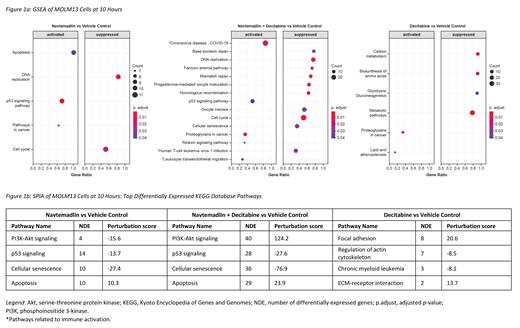Abstract
Background: Murine double minute 2 (MDM2) is the primary negative regulator of the tumor suppressor protein, p53. Navtemadlin (KRT-232), a potent, selective, orally available MDM2 inhibitor, restores p53 activity to drive apoptosis of cancer cells in TP53 WT malignancies through the intrinsic (mitochondrial) pathway. Navtemadlin is being evaluated in a phase 3 trial in relapsed or refractory myelofibrosis, and in phase 1b/2 trials in various hematologic malignancies and solid tumors. Because p53 is infrequently mutated and MDM2 is often overexpressed in acute myeloid leukemia (AML), navtemadlin represents a rational therapeutic candidate (Prokocimer et al. Blood. 2017). Synergy between navtemadlin and the hypomethylating agent decitabine has been demonstrated in preclinical AML models (Canon et al. AACR. 2016), although the mechanisms mediating this effect remain unclear. The present study aims to identify mechanisms of navtemadlin-mediated apoptosis within AML cell lines, timing of pathway activation, and effects of combination treatment with navtemadlin + decitabine.
Methods: MOLM13 or MV-4-11 AML cell lines were treated with a vehicle control, 0.5-1.0 µM navtemadlin, 1.0 µM decitabine, or with a combination of navtemadlin + decitabine. Cells were pretreated with decitabine for 42-48 hours followed by navtemadlin + fresh decitabine for 0, 5, 10, or 24 hours, and were then harvested for RNA-Seq and immunoblotting analyses of apoptotic pathway proteins. Gene set enrichment analysis (GSEA) and signaling pathway impact analysis (SPIA) were performed on RNA-Seq data to determine the most differentially regulated pathways (using KEGG curated signaling pathways) between controls, single-agent navtemadlin or decitabine, or combination treatment. Protein expression analyses were conducted to validate RNA-Seq data.
Results: GSEA of MOLM13 and MV-4-11 cells at 10 hours showed that, relative to controls, several signaling pathways were differentially regulated to a statistically significant level (P≤0.05) with navtemadlin alone, including activation of apoptosis and p53 signaling pathways, and suppression of DNA replication and cell cycle pathways, in line with previous reports (Figure 1a). In MOLM13 cells treated with single-agent decitabine, lipid and proteoglycan-related signaling pathways were activated, whereas several metabolic pathways were suppressed. With combination treatment in both cell lines, unique activated pathways relative to controls included immune-related and cancer-signaling pathways; and unique suppressed pathways included base excision repair and cellular senescence pathways. SPIA analysis of both cell lines at 10 hours produced higher perturbation scores for apoptosis and p53 signaling pathways with combination treatment vs navtemadlin alone (Figure 1b), indicating more robust pathway activation. Additionally, tumor microenvironment (TME) and extracellular matrix (ECM) remodeling pathways showed more robust perturbation when combined with navtemadlin vs decitabine alone. At 24 hours, only SPIA was conducted, which showed less apoptotic pathway induction relative to 10 hours in both cell lines, suggesting time-dependent signaling effects. Cellular senescence pathways were suppressed, whereas central carbon metabolism and HIF-1 signaling were induced by single-agent navtemadlin relative to controls in both cell lines, with combination treatment further enhancing these effects. Combination treatment also induced significant changes in the expression of ECM remodeling genes including MMP9, MMP2, and ITGB7. Protein expression analyses in both cell lines confirmed early upregulation of key apoptosis regulators including p53, p21, PUMA, cleaved caspase-3 and cleaved-PARP with navtemadlin alone, and the DNA-damage response protein, yH2AX, with decitabine alone. The combination enhanced the induction of p53, p21, and yH2AX vs controls or single agents alone.
Conclusion: Initial results from this study suggest that navtemadlin + decitabine enhanced apoptosis and p53 signaling pathways to a greater degree than either single agent in AML cell lines. Combination treatment also induced several unique DNA damage response, ECM-remodeling, and TME-related pathways. Activation of both proapoptotic and tumor-stromal interaction pathways suggest a unique mechanism of navtemadlin + decitabine for inhibiting AML cell growth.
Valmeekam: Telios Pharmaceuticals: Current Employment, Current holder of stock options in a privately-held company, Other: travel, accommodations, expenses. Canon: Oncovalent Therapeutics: Current Employment; Amgen, Inc.: Current holder of individual stocks in a privately-held company, Ended employment in the past 24 months. Krejsa: Acerta Pharma: Current holder of individual stocks in a privately-held company; AstraZeneca: Current equity holder in publicly-traded company; Seattle Genetics: Current equity holder in publicly-traded company, Divested equity in a private or publicly-traded company in the past 24 months; Kartos Therapeutics: Current Employment, Current holder of stock options in a privately-held company, Other: travel, accommodations, expenses. Kelly: AstraZeneca: Consultancy; Bayer: Speakers Bureau; Verastem: Consultancy; Amgen: Consultancy; Berkley Lights: Current equity holder in publicly-traded company; Denovo Biopharma: Consultancy; Takeda: Consultancy; Sanofi-Aventis: Consultancy; Novartis: Speakers Bureau; Janssen: Speakers Bureau; Agios: Current equity holder in publicly-traded company; Celgene: Speakers Bureau; Epizyme: Speakers Bureau; Pharmacyclics: Speakers Bureau; Karyopharm: Speakers Bureau; Gilead: Speakers Bureau.
Yes, navtemadlin (KRT-232) is an investigational small molecule inhibitor.


This feature is available to Subscribers Only
Sign In or Create an Account Close Modal